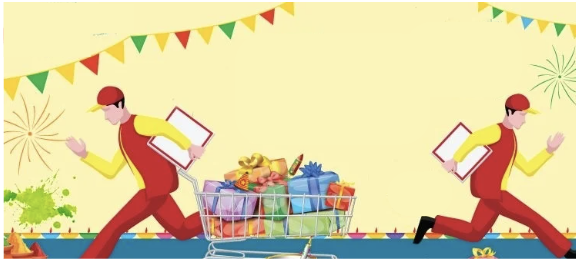As festivals approach, newspapers, TV, radio, and digital media are flooded with advertorials rather than content. Stepping out to a bustling shopping street, it feels claustrophobic yet enticing. Have you ever wondered why the increase in festive sales transcends commodities, prices, cities, and age groups?
A need that can be fulfilled with delight and instant gratification is a powerful force, not just a psychological tactic. Festivals provide the perfect backdrop for businesses to craft campaigns that trigger these covert consumer needs:
1) Power of Positive Emotions
Whether it’s a national holiday or festivals like Holi, Diwali, Christmas, New Year, Valentine’s Day, Eid, or Guruparv, campaign designers tap into consumers’ feelings of joy, warmth, comfort, celebration, and togetherness. This feel-good appeal gives consumers positive reinforcement, making it easier for them to spend money on both planned and impulse purchases.
2) Power of Unconscious Symbolism
Some festivals are symbolically associated with new beginnings, wealth, or prosperity. For instance, new clothes, gadgets, décor, and sweets are commonly purchased, associating newness with festivals. Gold symbolizes wealth, while diamonds are linked to “forever.” This explains the surge in gold and jewelry purchases during certain festivals. Gold, often passed down as heirlooms, is assumed to retain or increase its value over time.
3) Power of Aspiration
Aspiration leads to status-driven purchases. Like gold, there is also a surge in car and two-wheeler sales, as well as housing project bookings during festive seasons. Social status is tied to material possessions, with cars and houses signaling upward mobility. Companies cater to these aspirations through low-interest rates and special deals, making large investments appealing. Celebrity endorsements further appeal to consumers who aspire for luxury, sophistication, or popularity by wanting to embody a particular lifestyle.
Aspirational imagery—such as idealized family gatherings, lavishly decorated homes, and coordinated attire—enhances the consumer’s hope of a picture-perfect life, nudging them to make purchases. Limited Edition Collections highlight exclusivity, becoming a motivator for elevating social status.
4) Power of Scarcity and Urgency
Commonly known as FOMO (Fear of Missing Out), scarcity and urgency trigger impulse buying. Campaigns create a sense of urgency by suggesting limited supply. This principle appears in exclusive deals, limited-period offers, flash sales, and same-day delivery promotions.
5) Power of Reciprocity
Humans are wired to reciprocate kindness and avoid being seen as ungrateful. Gifting during festivals is an unconscious obligation, reciprocated frequently. Companies capitalize on gifting behavior by offering gift catalogs, personalized options, delivery services, beautiful packaging, and bulk purchase deals. Personalization is also used in shopping, food, travel, or entertainment apps, sending consumers personalized newsletters, messages, “only for you” offers, or loyalty rewards to encourage more purchases.
6) Power of Social Proof
Consumers often purchase ethnic wear, specific colors, or certain items to show solidarity and togetherness. People want to follow group norms and be included in celebrations, so they tend to purchase items to avoid exclusion. Peer pressure and social comparison are common advertising narratives that nudge consumers to match or exceed the spending of relatives or neighbors.
7) Power of Monetary Prudence
Consumers are more likely to buy if they feel they are getting something extra or at a lower price. Companies offer discounts and bundle products to increase the average purchase amount, leaving the customer satisfied—even if they buy something they don’t need.
Offering exchange bonuses on gadgets, FMCD, and cars plays into our tendency to avoid loss. An exchange bonus gives a sense of recovering lost value, reducing the perceived cost of a new product and encouraging upgrades to better, faster technology.
8) Power of Affordability
EMI (Equated Monthly Installments) options reduce anxiety about high upfront prices. EMI allows buyers to underestimate their total festive expenditure by psychologically distancing themselves from the total cost, splitting it into future payments. This taps into the tendency for instant gratification and increases credit use.
9) Power of Minimizing Guilt
Companies leverage themes like auspiciousness, rejuvenation, revitalization, and essential relationships to help consumers forget the financial impact of their spending. During festivals, many customers suspend their usual budgeting discipline, resuming it afterward. Companies lure them with “special occasion” narratives that rationalize extra spending as part of an exceptional circumstance, helping consumers absolve themselves of guilt over non-essential purchases.
10) Power of Choice Making
Companies offer variety (in color, design), giving consumers a false sense of autonomy in making choices, which ultimately nudges them toward buying. Interestingly, companies sometimes sell the same product under three different brand names with minor specification and price differences. Regardless of the customer’s choice, the company still makes a sale.
The self and social image of an individual are largely driven by motives and values. The continuous cognitive overload of ad campaigns will eventually strike a chord with an unconscious need waiting to be satisfied. Wouldn’t it be great if buyers were aware of their deepest needs, so they could discern whether they are making a purchase decision or if the decision has already been made for them?
About the Author


